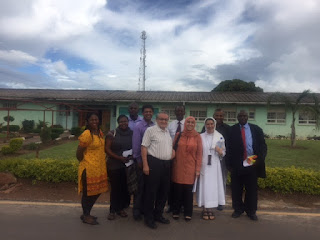It’s Carnival Saturday, I’m
reviewing some new cases just out of curiosity as I’m
wrapping up things at the lab today since the week of Carnival is a virtual
shut down of all operations in Trinidad.
Sherwin, our lab technologist who’s been trying to perfect the lab’s
Giemsa stain just stopped by for a chat about it. Dr. Greaves couldn’t see
neutrophillic granules on bone marrow smears, but now I think I see a few (yay
methanol fixation!). We talked about
writing an SOP so the conditions don’t change then having the lab director,
Dr. Greaves sign it and have it in a folder in the lab so that when another lab
technologist comes on board we won’t have to reinvent the wheel. Productive morning so far. Dr. Greaves is taking me out to lunch as a
thank you for the last two weeks of work so I’m using his office while he wraps up
some grossing.
 |
| Slide session #2 at the hospital |
Yesterday, I went to a hospital about 1.5 hours away from the lab
and sat in 2.5 hours of traffic to get there, in rain with very little gas thus
no air conditioner. I was a soaked
sweaty mess of a human walking into the Department of Pathology in San Fernando
(a teaching hospital in Trinidad and Tobago), with surgeons, surgery residents,
pathologists and pathology residents waiting.
I was 30 minutes late for a slide session that was scheduled at 10am and
had to be back up to Dr. Greaves’ lab for another talk on molecular
pathology by 1pm. Of days I’ve
had so far in Trinidad yesterday was my most exhausting but perhaps my most
rewarding. It rains for 3 hours straight
here at a time by the way, and then the sun comes out, the birds sing etc etc… But it rains and it rains hard, and it floods
and people just stop on highways for no other reason than just to stop their
cars. Vent over. My talk in San Fernando went well I think, I
couldn’t answer a few of the questions.
 |
| Because I had to, the parking lot at the teaching hospital, parking skills are a must.. |
The level of sophistication despite their
resource restriction at the government hospital still amazes me. Again, as I said in the first post, this has
to be one of the most fulfilling experiences I’ve had career-wise so far.
I’m going to spend next week Monday and
Tuesday in Trinidad ‘playing Carnival’. ‘Playing Carnival means putting on a
costume and dancing in the streets. I’ll
be with my sister, her friends and my best friend from high school. I ‘play’ in a band called Bliss (incredibly
appropriate) on Monday and Tuesday. But,
before all that, I’m going to (voluntarily) wake up at
3am, put on the oldest t-shirt and shorts I own and go get (again, voluntarily)
smothered with mud to ring in the actual Carnival celebration. That festival is called J’ouvert
(the opening).
 |
| Steelpan (Trinidad's national instrument) rehearsals for the big competition (Panorama). |
The Carnival tradition began with French settlers in Trinidad, it’s
akin to Mardi Gras in New Orleans. It’s
a release of the flesh of sorts, a sinning time before the cleansing and
penance of Ash Wednesday and Lent. The
history of it all is quite interesting in Trinidad. Prior to 1880 or thereabouts, only the
aristocrats (the bourgeois) could ‘play’ Carnival on Monday and Tuesday. In Trinidad at the time, it meant the
whites. Then came the Canboulay
riots. Freed slaves wanted to
participate in the celebration of ‘mas’ and weren’t
allowed to do so. In 1880, they burnt
sugar canes (hence ‘cannes brûlées'
into ‘Canboulay’ - Trinidad was once a French colony
so French patois words still persist) and protested in the streets for their
right to play. And play they did. Carnival became a unifying celebration of the
races and classes, where there was dancing in the streets for two days, begun
by J’ouvert and ended by last lap on Tuesday. It is an expression of the culture, the
country and the people. Your salary,
your nationality, your skin color and your dance is inconsequential, as long as
you have a good vibe, ‘yuh in ting’
(Trinidadian for: you’re all set).
I clearly paused the blog writing to ‘play
mas’ and am finishing this up back in the cold that is
Boston. I had quite the time dancing in
the streets, working in the lab, teaching the residents and everything in
between. I’m a little sad to have left. In Trinidadian lingo, I have a little bit of
a ‘tabanca’ but in some ways I’m
also glad to be back to continue the collaboration, the inspiration and the
good vibe.
 |
| Edible arrangement from the lab, a welcome back to the cold from my new friends in Trinidad. |









